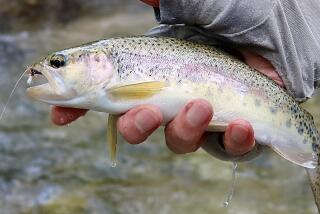Deep thinkers? You bet
- Share via
TROUT MAY NOT BE as good at minesweeping as dolphins, and their vocabulary may be a shade less than Koko the gorilla’s, but nobody is going to tell me that these masters of evasion don’t have a lot going on between the gills. Making people scramble from rock to rock to hover over pools with no fish in them is a sport for river trout.
To have any chance at all, you have to cop to this: They’ve got the upper fin -- until you understand the mysterious world of the inner trout. As any respectable trout therapist could tell you, besides eating and spawning, the fish has two prime drives, rest and fear.
“Trout have to reduce the amount of energy they’re putting out, and all feel a need for some sort of cover, a refuge from predators,” says Thomas Jenkins, a fish biologist who has studied trout since the 1960s.
The slacker mentality even overrules hunger. They aren’t built to swim 24/7, so they seek downtime in protected and placid water -- around rocks and in depressions. They also like to bask atop vegetation where the flow is minimal.
But, because they are highly individualistic creatures, trout like to be contradictory. They also hang out in turbulent water, either in the cushion of current behind boulders, from where they can pop up and grab passing food, or, in the case of rainbow, they float under the ripples and froth of rapids to hide from predators.
Well before the first efficiency expert harassed the planet, energy-conservation-minded trout had mastered the art of selective effort. When food is plentiful, a trout may not go more than a few inches out of its way to nab a bug, but it may travel 100 yards for a good-sized meal such as a sculpin.
“They will expend the least amount of calories to get the most amount of calories. Those that don’t do that don’t live very long,” says Ralph Cutter, author of “Sierra Trout Guide,” who has spent thousands of hours swimming and filming in icy waters to see what trout are up to.
Trout finickiness grows with age, something Jenkins has observed during his own underwater trout studies. Bait that doesn’t look, move or feel like the real thing won’t inspire them. “I’ve seen trout 3 or 4 years old -- I’d put in food way upstream, and they’ll come up to look at it, drop downstream in back of it, and then they’ll go back to the bottom and let it drift by. Very picky.” As much as they enjoy turning us into exasperated ripple gazers, trout down deep have their issues, like fear. The world is filled with perils -- osprey, bigger trout, the occasional not-so-hoodwinkable rod and reeler.
Although there are no doubt some well-adjusted trout, most fall into the acutely paranoid category, flinching at the slightest alteration to norm overhead. With few natural predators below the waterline, though, trout feel more secure. Cutter can swim right up to them, and they’re as blase as a denizen of Hollywood Boulevard.
Shadows moving along the river bank or the wrong trajectory of rod -- tipped up instead of down or parallel to the water or cast overhead instead of sideways, says Cutter -- will send trout diving to the bottom. A brown trout might stay in its hide-out for 20 minutes up to an hour. Threat-detection equipment fuels anxiety. Minus lids, trout eyes constantly look for trouble and can spot danger 100 yards away outside the water.
“You have to keep out of sight,” advises Jenkins. “Trout have a very good field of vision forward and upward. You walk up to a stream bank and drop in a line; if they’re wild trout, it will scatter them. They’re also very sensitive to low-frequency noises, so you have to be quiet.”
Thinking like a trout should ultimately lead to their favorite hangout, a place where they can be as fat, lazy and safe as they want to, the elusive “prime lie.”
A typical plum residence, says Cutter, would be “a logjam downstream of a riffle. The riffle will produce the food, and a trout hidden in that logjam will be fed without exposing himself to currents.”
It’s up to you to blow it from here.
Joe Robinson is author of “Work to Live.”
